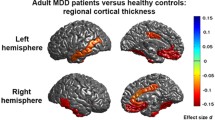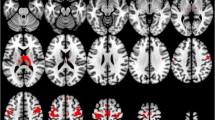Abstract
Purpose
The aim of this study was to determine whether the brain size of young patients with depressive symptoms is smaller than that of healthy controls using magnetic resonance imaging (MRI).
Materials and methods
We retrospectively evaluated brain size by calculating the ratio of the brain area to that of the skull (the brain-to-skull ratio) on routine MRI scans including the splenium of the corpus callosum obtained from 19 patients <40 years old with depressive symptoms in 2009. The controls were 12 healthy individuals <40 years old who underwent MRI for medical examinations.
Results
The mean brain-to-skull ratio of the control group was 0.850 ± 0.022 (range 0.822–0.889), and that of the patient group was 0.819 ± 0.041 (range 0.756–0.878). An unpaired t-test showed a significant difference in the brain-to-skull ratios between these groups (P = 0.011). In particular, in 7 of the 19 patients with longer duration of illness and more severe symptoms, the brainto-skull ratio was 89%-92% of the mean ratio of the control group.
Conclusion
The brain size of young patients with depressive symptoms appears to be smaller than that of healthy controls.
Similar content being viewed by others
References
Jack CR, Petersen RC, Xu Y, O’Brien PC, Smith GE, Ivnik RJ, et al. Rates of hippocampal atrophy correlate with change in clinical status in aging and AD. Neurology 2000;55:484–489.
Xu Y, Jack CR, O’Brien PC, Kokmen E, Smith GE, Ivnik RJ, et al. Usefulness of MRI measures of entorhinal cortex versus hippocampus in AD. Neurology 2000;54: 1760–1767.
Du AT, Schuff N, Amend D, Laakso MP, Hsu YY, Jagust WJ, et al. Magnetic resonance imaging of the entorhinal cortex and hippocampus in mild cognitive impairment and Alzheimer’s disease. J Neurol Neurosurg Psychiatry 2001;71: 441–447.
Adachi M, Kawakatsu S, Hosoya T, Otani K, Honma T, Shibata A, et al. Morphology of the inner structure of the hippocampal formation in Alzheimer disease. AJNR Am J Neuroradiol 2003;24:1575–1581.
Kitagaki H, Mori E, Hirono N, Ikejiri Y, Ishii K, Imamura T, et al. Alternation of white matter MR signal intensity in frontotemporal dementia. AJNR Am J Neuroradiol 1997;18: 367–378.
Kao AW, Racine CA, Quitania LC, Kramer JH, Christine CW, Miller BL. Cognitive and neuropsychiatric profile of the cynucleinopathies: Parkinson disease, dementia with Lewy bodies, and multiple system atrophy. Alzheimer Dis Assoc Disord 2009;23:365–370.
Monastero R, Manqialasche F, Cmarda C, Ercolani S, Camarda R. A systemic review of neuropsychiatric symptoms in mild cognitive impairment. J Alzheimers Dis 2009;18: 11–30.
Weiss EM, Kohler CG, Vonbank J, Stadelmann, Kemmler G, Hinterhuber H, et al. Impairment in emotion recognition abilities in patients with mild cognitive impairment, early and moderate Alzheimer disease compared with healthy comparison subjects. Am J Geriatr Psychiatry 2008;16:974–980.
Ravaqlia G, Forti P, Lucicesare A, Rietti E, Pisacane N, Mariani E, et al. Prevalent depressive symptoms as a risk factor for conversion to mild cognitive impairment in an elderly Italian cohort. Am J Geriatr Psychiatry 2008;16: 834–843.
Stepanniuk J, Ritchie LJ, Tuokko H. Neuropsychiatric impairments as predictors mild cognitive impairment, dementia, and Alzheimer’s disease. Am J Alzheimers Dis Other Demen 2008;23:326–333.
Chen MC, Hamilton JP, Gotlib IH. Decreased hippocampal volume in healthy girls at risk of depression. Arch Gen Psychiatry 2010;67:270–276.
Takahashi T, Yvcel M, Lorenzetti V, Tanino R, Whittle S, Suzuki M, et al. Volumetric MRI study of the insular cortex in individuals with current and past major depression. J Affect Disord 2 2010;121:231–238.
Frodl TS, Koutsouleris N, Bottlender R, Born C, Jäger M, Scupin I, et al. Depression-related variation in brain morphology over 3 years: effects of stress? Arch Gen Psychiatry 2008;65:1156–1165.
Yucel K, McKinnon MC, Chahal R, Taylor VH, Macdonald K, Joffe R, et al. Anterior cingulate volumes in never-treated patients with major depressive disorder. Neuropsychopharmacology 2008;33:3157–3163.
Frodl T, Schaub A, Banac S, Charypar M, Jäger M, Kvmmler P, et al. Reduced hippocampal volume correlates with executive dysfunctioning in major depression. J Psychiatry Neurosci 2006;31:316–323.
American Psychiatric Association. Diagnostic and statistical manual of mental disorders (text revision). 4th edn. Arlington, VA: APA; 2000.
Schuckit MA. Alcohol-use disorders. Lancet 2009;373:492–502.
Ganz D, Sher L. Suicidal behavior in adolescents with comorbid depression and alcohol abuse. Minerva Pediatr 2009;61:333–347.
Fukuda K, Yuzuriha T, Kinukawa N, Murakawa R, Takashima Y, Uchino A, et al. Alcohol intake and quantitative MRI findings among community dwelling Japanese subjects. J Neurol Sci 2009;278:30–34.
Paul CA, Au R, Fredman L, Massaro JM, Seshadri S, Decarli C, et al. Association of alcohol consumption with brain volume in the Framingham study. Arch Neurol 2008;65: 1363–1367.
Anstey KJ, Jorm AF, Réqlade-Meslin C, Maller J, Kumar R, von Sanden C, et al. Weekly alcohol consumption, brain atrophy, and white matter hyperintensities in a communitybased sample aged 60 to 64 years. Psychosom Med 2006;68:778–785.
Ding J, Eigenbrodt ML, Mosley TH Jr, Hutchinson RG, Folsom AR, Harris TB, et al. Alcohol intake and cerebral abnormalities on magnetic resonance imaging in a community-based population of middle-aged adults: the Atherosclerosis Risk in Communities (ARIC) study. Stroke 2004;35: 16–21.
Lee E, Janq DP, Kim JJ, An SK, Park S, Kim IY, et al. Alteration of brain metabolites in young alcoholic without structural changes. Neuroreport 2007;18:1511–1514.
Haider A, Miller DR, Staton RD. Use of serotonergic drugs for treating depression in older patients. Geriatrics 1993;48: 48–51.
Vaswani M, Linda FK, Ramesh S. Role of selective serotonin reuptake inhibitors in psychiatric disorders: a comprehensive review. Prog Neuropsychopharmacol Biol Psychiatry 2003;27: 85–102.
Halbreich U, Tworek H. Altered serotonergic activity in women with dysphoric premenstrual syndromes. Int J Psychiatry Med 1993;23:1–27.
Benfield P, Heel RC, Lewis SP. Fluoxetine: a review of its pharmacodynamic and pharmacokinetic properties, and therapeutic efficacy in depressive illness. Drugs 1986;32:481–508.
Post RM. Role of BDNF in bipolar and unipolar disorder: clinical and theoretical implications. J Psychiatr Res 2007;41: 979–990.
Aydemir O, Deveci A, Taskin OE, Taneli F, Esen-Danaci A. Serum brain derived neurotrophic facter level in dysthymia: a comparative study with major depressive disorder. Prog Neuropsychopharmacol Biol Psychiatry 2007;31:1023–1026.
Otsuki K, Uchida S, Watanuki T, Wakabayashi Y, Fujimoto M, Matsubara T, et al. Altered expression of neurotrophic factors in patients with major depression. J Psychiatr Res 2008;42:1145–1153.
Duman RS, Monteggia LM. A neurotrophic model for stressrelated mood disorders. Biol Psychiatry 2006;59:1116–1127.
Shin RA, Belmonte PL, Zandi PP. A review of the evidence from family, twin and adoption studies for a genetic contribution to adult psychiatric disorders. Int Rev Psychiatry 2004;16: 260–283.
Ashburner J, Friston KJ. Voxel-based morphometry: the methods. Neuroimage 2000;11:805–821.
Ohnishi T, Matsuda H, Tabira T, Asada T, Uno M. Changes in brain morphology in Alzheimer disease and normal aging: Alzheimer disease an exaggerated aging process? AJNR Am J Neuroradiol 2001;22:1680–1685.
Author information
Authors and Affiliations
Corresponding author
About this article
Cite this article
Adachi, M., Shibata, A., Sato, T. et al. Smaller brain size likely in young adults (<40 years old) with depressive symptoms compared to healthy controls: a retrospective study. Jpn J Radiol 29, 19–24 (2011). https://doi.org/10.1007/s11604-010-0509-y
Received:
Accepted:
Published:
Issue Date:
DOI: https://doi.org/10.1007/s11604-010-0509-y




